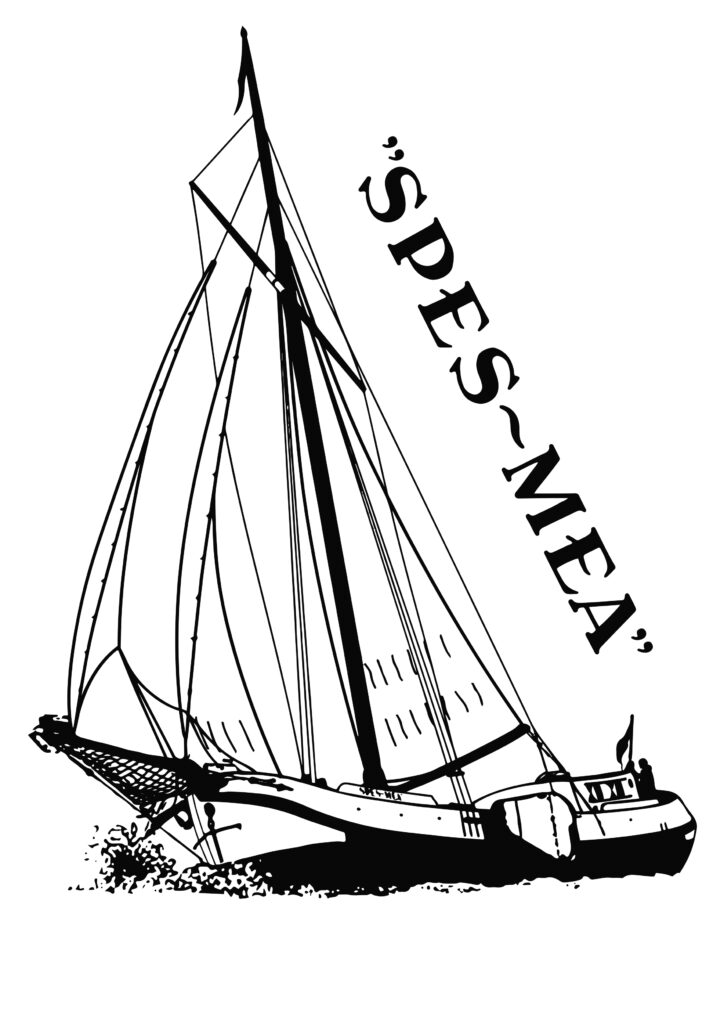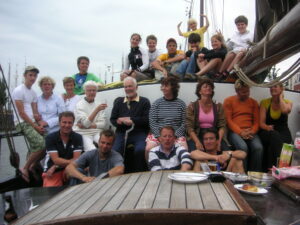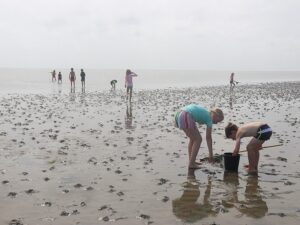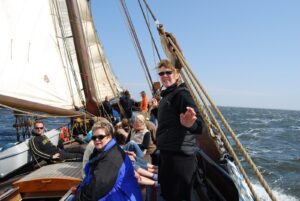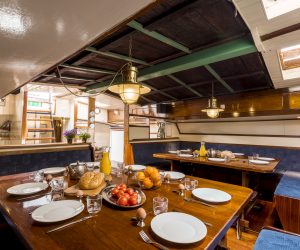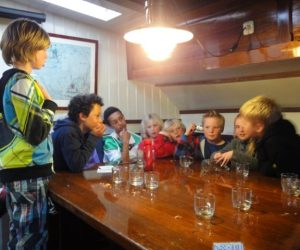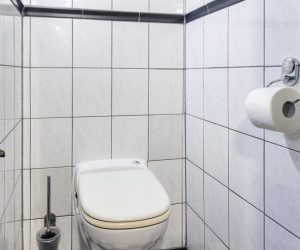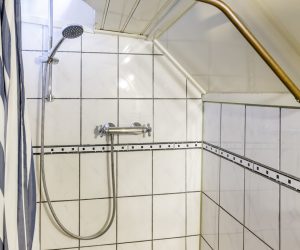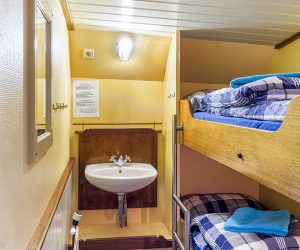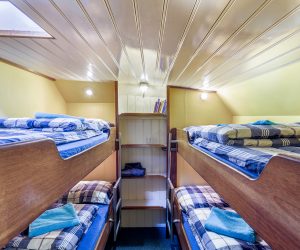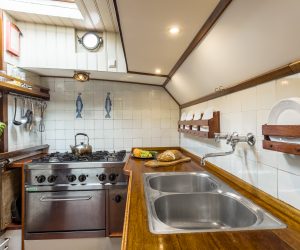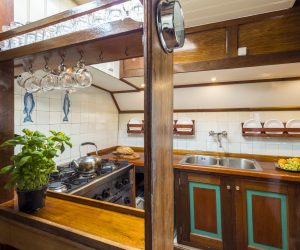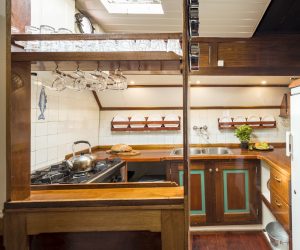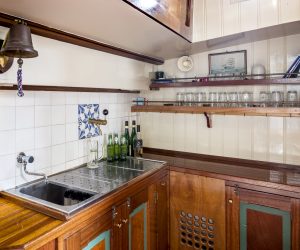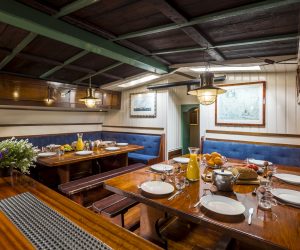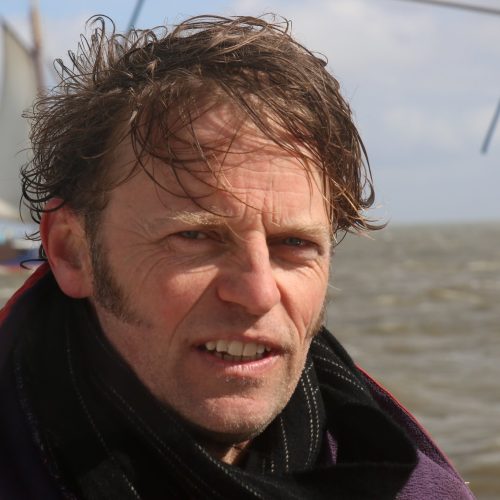Spes Mea
Home » Spes Mea
Why sailing with the Spes Mea ?
Because the Spes Mea is a beautiful ship she deserves to be well maintained. In addition, we value safety and durability.
REQUIREMENTS
The Spes Mea meets all the requirements of the Inland Waterways Shipping Act
SPACE
There is plenty of seating, lounging and relaxing space on deck
CREW
The Spes Mea has a very experienced crew
STABILITY
The Spes Mea is a stable ship with good sailing characteristics
CABINS
Mainly 2-bed cabins with a sink, heating and ventilation options. Comfortable berths (beds) 80x200cm (8 of 210 cm)
GTL
From 2019 we will be sailing on GTL (Gas To Liquid). When the DAF goes on it is without soot emission
STANDING HEIGHT
Headroom throughout the ship except in the deckhouse 😉
SANITARY
Luxury toilet (ladies & men's rooms) and 2 separate spacious showers
DRAUGHT
Low draft (1.20 m) makes the entire Wadden Sea navigable.
ATMOSPHERE
The crew and ship create a friendly, sociable and welcoming atmosphere The interior goes the extra mile.
CATERING
Experienced in-house catering by Caro van der Meulen. http://www.carokookt.nl
GUARANTEE FUND
All trips are covered under the VZR Guarantee Fund.
The interior
Inside the ship you will find a cozy salon with two large tables surrounded by upholstered benches. In the kitchen there is a large catering stove with 6 burners. Good pans, kitchen utensils, sufficient plates etc. etc.; the kitchen is well equipped. A cook is licking his fingers! Next to the stairs is a tap installation from which you can tap a cold beer if you wish. The sanitary facilities consist of two toilets and two spacious showers. On the floor plan you can get a good impression of the layout of the ship and the cabins. The Spes Mea is a spacious, practical and warmly decorated ship.
The plan of the Spes Mea
The outside
Rigging
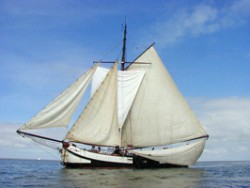
Below is an illustration of the standard rig of a tjalk.
Under the boom, the water sail can be run when upwind and downwind. Besides the ‘standard jib’ there is also a large jib on board for the somewhat lighter weather types. Total: approximately 320 m2 of sailing pleasure.
Furthermore, it is easy to see that the mast is braced with various stays (steel wires) running from the top of the mast to the hull. This is to give the mast stiffness in relation to the hull. One forward, the forestay, along which the jib can be hoisted. 4 Stays to starboard and port. All of these are fixed. 
Beside the ship hang the swords. These large wooden “planks” protrude into the water on leeward side. They prevent drifting flatboats have no keel.
The hull
A tjalk can be recognized by her round bow and stern. The gunwale, upper edge of the ship, slopes slightly inward here. The gunwale, the fender around the ship, is heavy on the head and stern of the ship. The bow and stern beam are also heavy. Attached to the stern is the so-called attached rudder. On top of the rudder, the tiller is usually attached. But many large tjalks are now equipped with a steering wheel. Such is the case with the “Spes Mea.” The tjalk is actually the archetype of the Dutch cargo ship. In the early days it was exclusively made of wood. After about 1880, these ships were built of iron. The material changed, the shape remained. Especially the flat bottom is very typical for these boats. Tjalks, but also other types of ships, are also called flat bottomed. They could sail well through the often shallow waters of the Netherlands.
All technical data of the “Spes Mea” can be found on the technical data page.
Technical data
Technical data
- Length 26 meter
- Width 5,40 meter
- Sail area: 240m2,
Including additional sails: 410m2 - Mast: 23,5 meter
- Draft: 1.20 meters
- Engine: Daf 1160 with 186 HP
Facilities
- 20 beds
- 6 double cabins with hot/cold running water, central heating
- 2 four-person cabins with hot/cold running water, central heating
- 2 showers with central heating
- 2 toilets (Sanibroyeur)
- professional kitchen, including electric oven
Capacity
- overnight stay: max. 20 persons
- day trip: max. 25 persons
Rigging
Some 1,400 metres of rope and 350 metres of steel wire were used for the rig.
SPARS
- Mast: 23,5 meter
- Boom: 13,5 meter
- Gaff: 7 meter
- Jib-boom: 7 meter
- Bowsprit: 7 meter
Sails
- Mainsail: 134 m2 (3 reven)
- Jib: 63 m2 (1 rif)
- Small foresail: 28 m2
- Big foresail: 50 m2
- Watersail: 20 m2
Winches
- 2 daggerboard winches (hydraulically driven)
- Mainsailwinch (mainsail halyards, foresail halyards)
- Mainsailsheetwinch (mainsailsheet))
- anker windlass (stoch- and kedge anker)
- lewmar winch (forersail sheets)
Technique
Engineroom
- Main engine Daf 1160(186 HP)
- Reverse clutch: PRM 1000D
- Generatorset: Mitsubishi 9,5 kVa
- Batteries: Tractieset 690 amp/h
- Inverter/charger:: Victron 3000 Watt/70 Amp.
- Heating/hot water:diesel-fired central heating boiler
- Hydrophore: Speck
- Bilge/wash/dirty water pump
Navigation
- magnetkompass
- GPS (satellitenavigation)
- WinGPS on laptop
- AIS (transponder ship data)
Tanks
- Diesel: 0,84 ton / 1000 liter
- Drinkwater: 4,6 ton / 4600 liter
- Dirty water: 1 ton
Tour
History of the Spes Mea
Beltvessel
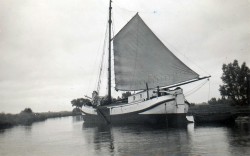
Inland vessel
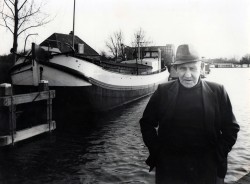
In 1938, when the Spes Mea could no longer compete with newer larger sea-going vessels, it became an inland waterway vessel (the last sea voyage, carrying peat, had lasted a month and had yielded only 300 guilders). In inland navigation, the maximum water displacement was 168 tonnes; the cargo was mainly bulk cargo. Krook sr. was (fortunately) rather conservative; while colleagues built larger ships and removed rigging, he continued to sail. Krook jr., however, was more than tired of sailing and when dad left the ship, the small auxiliary engine was removed and replaced by a 2 cylinder Deutz of 38hp. The sailing rigging was removed so that the cargo hold could be enlarged. This did not happen until 1954, much later than the fellow barges.
From houseboat to charter vessel
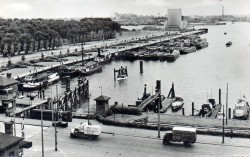
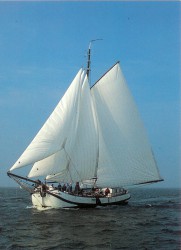
However, it did not like that form, so the Spes Mea was sold on to Jan van Berge in 1989. Even as a schoolboy, he knew the ship and had often visited the then owner. Jan restored the Spes Mea to her former glory and made her into what she is today; a beautiful sturdy seafaring tjalk.
In 1998, the ship, now a comfortable charter vessel with room for 20 guests and home port of Harlingen, became the property of Klaas Bosch and Danny Munnikes. In 2003, Danny left this two-man crew and now Klaas Bosch is the owner.
Our photo album has more pictures of the Spes Mea from the past.
